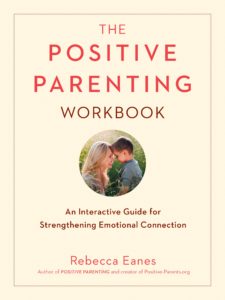Seeing Problem Behavior in a New Way by Rebecca Eanes, author, The Positive Parenting Workbook
Adapted from The Positive Parenting Workbook: An Interactive Guide for Strengthening Emotional Connection by Rebecca Eanes with the permission of TarcherPerigee, an imprint of Penguin Random House LLC. Copyright© 2018 by Rebecca Eanes
 Seeing Problem Behavior in a New Way
Seeing Problem Behavior in a New Way
Our culture is constantly feeding us negative ideas about children. When they are infants, we see them as blessings, gifts. We are quick to gush over newborn babies and how “innocent” and “sweet” they are. Oh, but wait just a few months and the message begins to change. Right about the time they learn to walk and talk, the warnings start to come. “He’s walking? You’re in trouble now.” “Just wait, the terrible twos are coming.” “Terrible twos? Ha! Threenagers are way worse.” “Oh yeah, just wait until he’s a teen!”
We are constantly told about how they will manipulate us, test our authority, push our buttons, and see what they can get away with. With the dire warnings come loads of advice telling us the best way to control our little tyrants—so they don’t control us.
Did the “terrible twos” message cause you fear or anxiety? If your child is two or older, do you think this influenced how you saw or interacted with your child during this stage? Were you looking for “terribleness”?
These toxic cultural messages poison our minds and negatively affect the way we see and therefore relate to our children. The clamor of the world drowns out the whispers of our hearts, and we end up viewing them not so much as our gifts anymore but as mischief to be managed.
In our earnest efforts to train them in appropriate behavior, we end up reducing children to little more than that, as though their behavior at any given moment is what defines them—good, bad, or some- thing in between. As I’ve pointed out, our kids are more than their ability to sleep through the night. They are more than their willing- ness to instantly obey. They are more than a grade. They are more than a mood. They are more than a snapshot of how well they be- haved that day, more than what we see on the surface. They are human beings—messy and beautiful, wild and compassionate, and worth getting to know, not just getting to mind. When we reduce them to the behavior they currently display, we miss out on seeing their beauty, their light, and ultimately their potential.
If we can correct, teach, and guide our children from a position of seeing the light within them rather than their momentary setbacks along the way, how much higher will they reach? I call this being a light reflector because we intentionally look for the light in them and reflect it back so they can see it, too. After all, children come to see themselves the way their parents see them.
What they see reflected in our eyes is often what they will become.
Will you be the person in your child’s life who always sees her light and reflects it back to her? That starts with looking for positive motives, even when she does something “bad.” Seeing your children’s motives as negative (“He’s trying to test me” or “She’s just pushing my buttons”) triggers your own negative reactions. As a result, you may become angry, embarrassed, or frustrated. In that triggered state, you may justify making her feel bad because in your mind, you’re doing it to make her a better person in the long run. So, you scold her for her wrongdoing, highlighting her character flaws and making her feel bad about herself. Unfortunately, when she sees her “badness” in your eyes, she may come to see herself as bad—not just her behavior, but herself. If that works its way into her self-concept, she’ll repeat the bad behavior because we behave how we see ourselves. See the person, the heart and soul, behind the screams, the eye rolls, the tantrums, the messy rooms, and the bad attitude. See their light and draw it out.
If, on the other hand, you choose to see positive intent, you see that she’s a good person who needs guidance on this issue. You still correct the behavior, but you approach her with a different tone and attitude, changing your language so that you’re reflecting her light. Remembering that she is a good person with positive motives who made a poor choice allows you to bring compassion to your correction, and that allows her to take it in  without damaging her developing self-concept.
without damaging her developing self-concept.
REBECCA EANES is the founder of Positive-Parents.org, creator of Positive Parenting: Toddlers and Beyond, and a contributing editor to Creative Child magazine. She is the author of Positive Parenting: an Essential Guide and The Positive Parenting Workbook.















